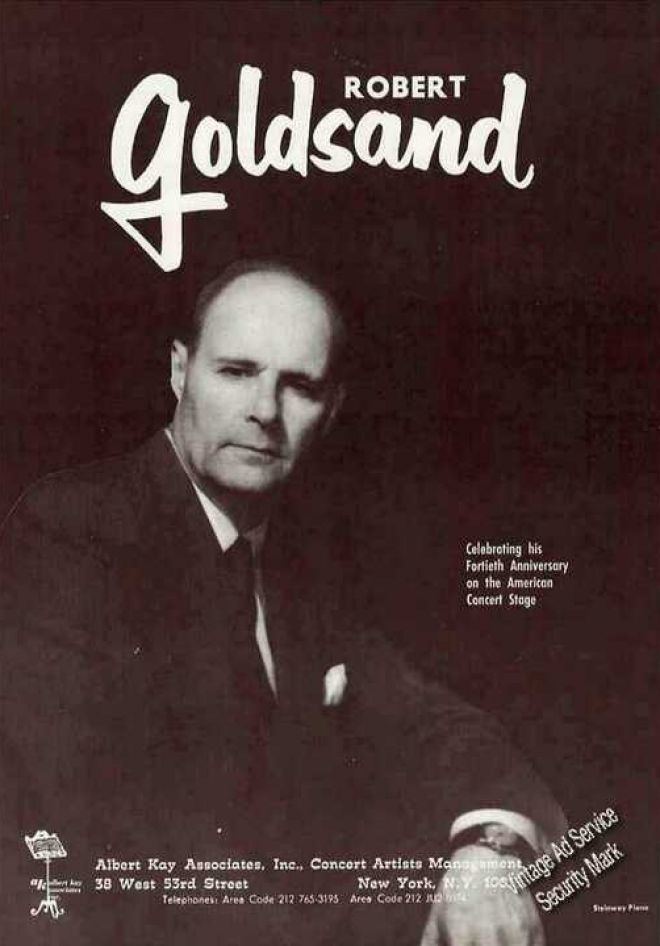Name Robert Goldsand | Role Classical pianist | |
 | ||
Similar People Moriz Rosenthal, Ralph Votapek, Simon Barere, Constance Keene, Artur Balsam | ||
Robert goldsand plays schumann sonata no 3 in f minor concerto without orchestra
Robert Goldsand (March 17, 1911 – September 16, 1991) was an Austrian-American classical pianist.
Contents
- Robert goldsand plays schumann sonata no 3 in f minor concerto without orchestra
- Robert goldsand plays chopin sonata no 2 op 35 in b flat minor
- Life
- Pedagogy
- Recordings
- Death
- References
Robert goldsand plays chopin sonata no 2 op 35 in b flat minor
Life
Goldsand was born in Vienna, Austria-Hungary in 1911, the son of artisan Jakob Goldsand and his wife Helene. He began musical studies at age four on the violin, but discovery of his talent for the piano, and consequent concentration on that instrument, began within a year. A student of Camella Horn, Joseph Marx, Emil von Sauer, and Moriz Rosenthal, Goldsand launched his performing career at age 10, in November 1921, with a concert in Vienna. Thereafter, he engaged in European and South American tours. [1] His US debut came in 1927 at Town Hall in New York City. His father Jakob died in 1929, and his mother Helene, who had accompanied Robert on several trips to the United States, died in 1937. Upon leaving Vienna to flee the Nazis — his parents were both Jewish — he settled in the United States in 1939, where he gave concerts and took a teaching position at the Cincinnati Conservatory. In 1949, at the invitation of the Chopin Centennial Committee, he performed a complete cycle of that composer's recital repertoire in six concerts. In 1951, Goldsand joined the faculty at the Manhattan School of Music [2], where he continued to teach until 1990. [3] In concert, his repertory ranged widely, embracing music ranging from J.S. Bach's Goldberg Variations through works of major 19th-century composers such as Beethoven, Chopin, Schumann, and Schubert; virtuoso performer-composers like Godowsky and Schulz-Evler; and such 20th-century composers as Hindemith. [4]
Pedagogy
Goldsand taught legions of students during his long tenure at the Manhattan School, as an Internet search for his name quickly reveals. Among the celebrated students were Suezenne Fordham [5], Neil Galanter, Harris Goldsmith [6], Anne Koscielny [7], Thomas Schumacher [8], and Ralph Votapek [9]. Henry Edmundson, a student for one year not long before Goldsand’s death, indicates that Goldsand, like any artist-teacher of his rank, expected the student to have memorized the work under study before taking a lesson, which would concentrate on interpretation; according to Edmundson, Goldsand was "a stickler for tradition" and demanded that the student adhere to Goldsand’s way of playing a piece. [10] Harris Goldsmith recalls Goldsand as a "pianistic charmer" with "debonair technical ease," citing an instance when Goldsand demonstrated with his left hand how to obtain the desired legato in the coda of Chopin's fourth ballade. [11] Goldsand's passion for Beethoven had a major influence on his pupils, particularly in the case of Dr. Kevin Moore, a prominent professor of piano at Onondaga Community College in upstate New York. Dr. Moore has performed all 32 of Beethoven's piano sonatas, in local performances to the public, which have become immensely popular.
Recordings
Most of Goldsand's recordings appeared on the American Concert Hall Society label. Later, Goldsand recorded for the American Desto and Decca labels. Very few of these LP issues have reappeared on compact disc.
Death
He died of diabetes in a Danbury, Connecticut nursing home, in 1991.
